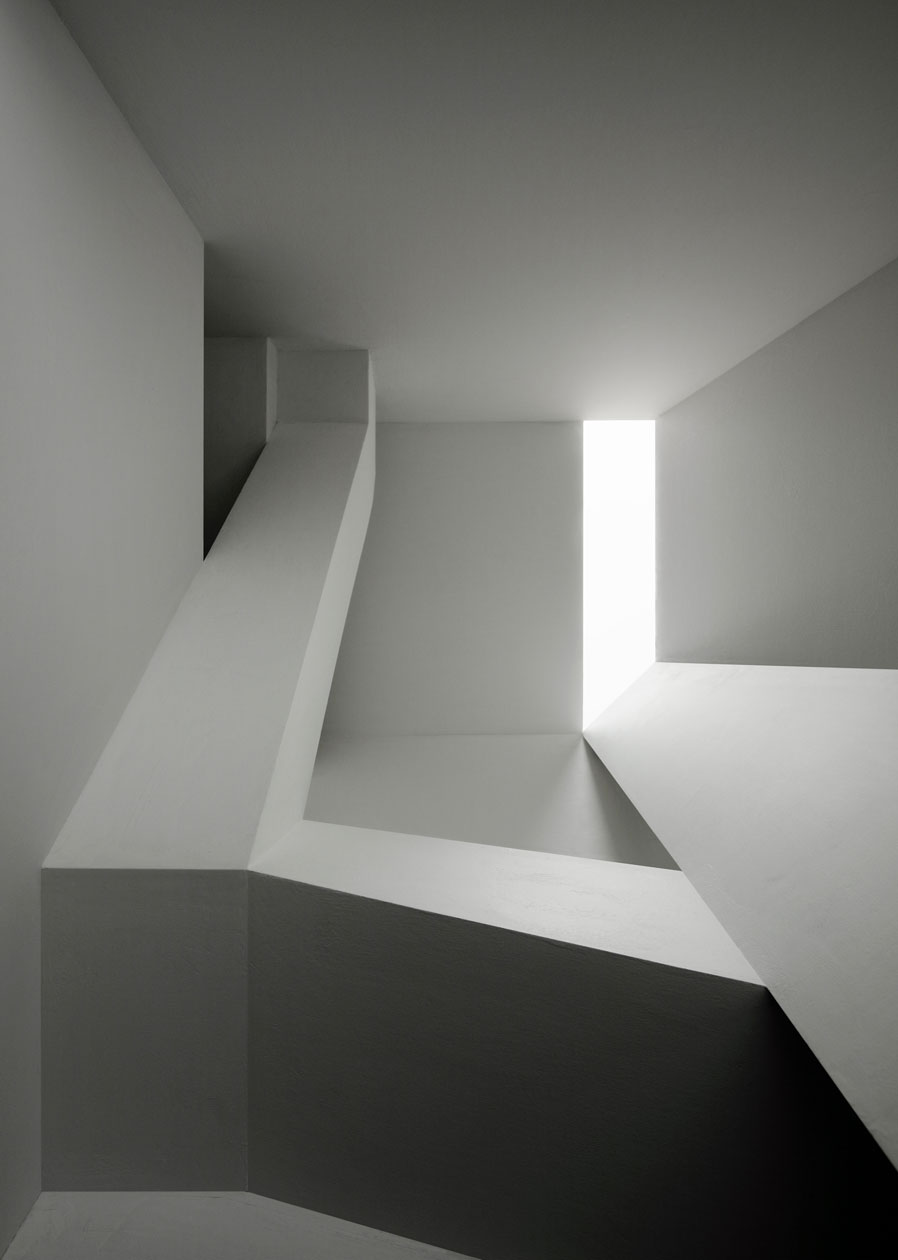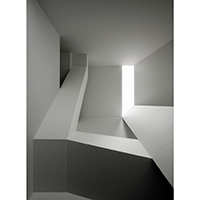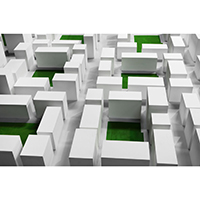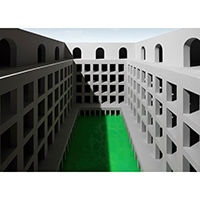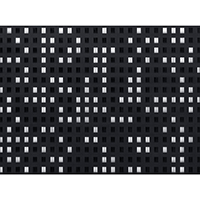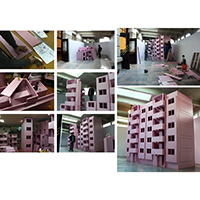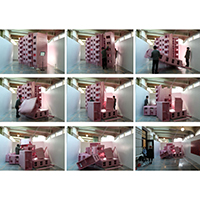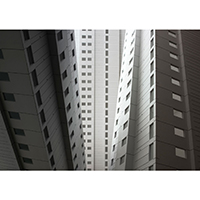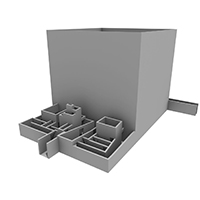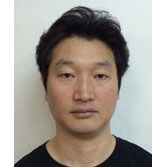
Moonho Lee, Total Museum of Art

Birth
1970, Seoul
Genre
Sculpture, Installation, Photography
Homepage
The Fantasy of Illusion Space making the Entertainment of Visual Perception
View 1. An empty space where there is no people and almost no furniture. What is there are the stairs, a door, columns and other architectural elements, a chair or a mirror. It is a familiar view of someone's bedroom, living room, or studio, but the viewers find the inside of this modern architecture rather unfamiliar. The feeling that something is lacking. The discomfort that something looks unnatural. Nevertheless, the audiences are accustomed to the photography of modern architecture and just accept the disappearance of people, accessories and color. They just view the inside of a dry and simple modern architecture in shadows.
View 2. The audiences casually observe the view of an empty dance studio that is surrounded by mirrors, and then they find an object next to it. They are attracted to look inside it and realize that what they have been seeing is not real. It was a miniature model. The isolation between the realistic appearances of the photographs and the lame appearances of what is real astonishes them. How could the photographs look so real!
View 3. The audiences appreciate the form of a space where light falls into. Then, they discover the model to realize that it was an illusion. Intrigued by the trick of visual illusion, the audiences observe the photographs and the model alternately to think what makes them think what they see is real. At that moment, they see other audiences passing behind the model that they thought was a mirror. Wasn't this... a mirror? They have already begun to doubt the transparency of perception. Now, they are in a complete chaos. What they saw was not seen.
The above patterns of viewing can be most frequently witnessed at Moon Ho Lee's exhibitions. The audiences can either experience one of them or all three of them simultaneously or one by one. Lee's works constantly ask the question whether what I see now is right. He makes wooden models of unidentified spaces in his memory to make photographs of them and makes spaces of fantasy that are similar to the reality using the strategy of illusion. Moving back and forth two and three dimensions, the fantasies remind you of the most essential questions of visual perception. What is it that I am seeing? How do I see it? In this respect, Lee is making a rather bold action to stir up the oldest question of visual art. Visual art, destined to substitute objects in the visual world, is born to rely on the visual imagination of viewers (whether it is right or misunderstood). No image can represent the entirety of an object; it just represents a certain aspect of the original. Not being able to see the real and the fact that the act of seeing always accompanies distortion are the forces that have driven the history of visual art that is thriving to create real-like fantasies. The questions that have risen in a pursuit of solutions penetrate through the artistic world of Lee. These are some of the questions: 'What is the procedure of seeing?', 'What causes fantasies?', 'What are the factors that influence the perception?', and 'What part does photography takes in this?'
We interpret the visual phenomena that we see in front of your eyes based upon our previous knowledge. In other words, we see what we know. Gombrich said that this is the first condition of fantasy. Because we 'cannot imagine any object that we have not seen,' we are blind to the possibility that what we see can be different from what we think it is. Perception (sensing that something is there) and cognition (knowing what it is) occur almost simultaneously, but they are not the same. The course of perception to cognition is intervened by knowledge acquired by learning and experience. We are able to say 'something is there' because we establish a hypothesis (assumption) that 'it would be something' by modifying what we perceive with the existing information in our brain and confirm that hypothesis through observation and revision. The process of perception is a dynamic interaction where seeing and knowing are exchanged continuously and never linear or clear.
Lee's works focus on this part where the conversion from perception to cognition occurs. His major interest is how much visual perception is influenced by induced projection and what the condition of fantasy is. His intention is not about making realistic fantasies like the painters of the past, but about breaking such fantasies. He makes the fantasies of the audiences slip and mismatch to help them realize that what they see is not obvious. In this respect, the audiences are the key element that completes the works of Lee who constantly puts a brake to the process of perceiving and interpreting fantasies. As the viewers, the audiences become active participants in Lee's game of seeing. The artist's illusions cannot be realized if the audiences match them through the act of interpretation. The audiences make assumptions about the works based on their previous knowledge and constantly modifying the assumptions in comparison to experiences. At that time, they are psychologically bound to see what they are assuming inside, and this causes misinterpretation. The process of cognizing an ordinary photography of architecture and realizing that it was a model and the process of realizing that a reflection on the mirror was actually a real space behind it are the repeated traces of cognition and misinterpretation where expectations are constantly betrayed.
If so, what we should discuss next is the contribution of the formal elements of works that make up the continued slipping of perception. The primary factor that leads to an illusion is the conversion of medium, or the conversion of dimension, in which he makes a model and takes photographs of it. This process is done by rather elaborately designed devices just to think that 'it is a mere picture of a model.' Comparing Lee's works to the similar works of Thomas Demand allows us to better understand the characteristics of Lee. Lee and Demand share many similarities in terms of formal characteristics and theme. There are differences in terms of materials (Lee uses woodrock; Demand uses paper or cardboard) and other details, but it is similar that both of them use models to create virtual spaces and photograph them for final products. Also, they have the common intention to explore the gap between cognition and misinterpretation. The point where they divide is the object of exploration. Demand focuses on the signifying process and their socio-cultural contexts that create stereotypes, whereas Lee focuses on the cognition of visual perception that occurs before the realm of decoding. Such difference in perception is reflected on every aspect of detail. Observing the cognition of visual perception itself, Lee has the tendency to eliminate all subsequent elements that interfere with the 'act of seeing.'
The difference comes into play from the start point. Unlike Demand who uses popular photographs that are widely distributed, Lee uses the spaces that are in his personal memories. School ((2004)), pub (<1992 winter>(2004)), dance studio ((2005)), and room ((2005)) are spaces that are conceptualized by memories and lack the characteristics that tell us their specific characters or history. With the intention to associate with certain spaces, Demand includes many accessories that define a space as an office, parking lot, or archive. On the other hand, Lee's spaces of memories are either empty or have minimal pieces of furniture besides windows, walls, and columns. Like a photograph that is filtered through memory, everything is blurred and assimilated in the process of fragmentation and the space filtered through memory appears like an ambiguous fantasy that excludes any details of reality. The simplified space without color or people looks familiar, but is strangely unfamiliar and different. It is not clearly defined and not completely closed. Such translucency is an important characteristic of the spaces Lee creates. The ambiguity of an illusion space where all details are deleted creates a place where people can focus on the act of seeing by eliminating everything that is to be seen. In other words, the sense of perception that is hardly realized or the process of cognizing something new is brought up to the surface. This is why it is not so important whether Lee's spaces are based on reality and even the space that has the most hints of the reality (<1992 winter>) has the feel of a fantasy that is rather unsubstantial. The fact that the separation of reality and virtuality is meaningless is clearly seen in (2006) that reproduced Escher's (1953). Lee was attracted to Escher's contradictory space not only because it did not exist, but also because the distorted space in which the stairs take us to where you were originally allows us to look back on the way we perceive 3D spaces. The illusion of (2006) that makes us dizzy by not showing us the end reveals how vulnerable our perception of distance is. Having to rely solely on vision without any other information, the audiences cannot determine where the passage ends. (The passage seems to be about 10m long, but it is actually only about 5m.)
Photography plays an enormous role in this game of seeing where recognition and misrecognition are repeated. Generally, photography has a dualistic character: the aspect of truthfulness to contain the reality and the aspect of composition to be manipulated by the photographer. Here, the latter is actively utilized. This is also where Lee forks from Demand who utilizes documentary photography. In case of Demand, he borrows the truthfulness of documentary photography that simply records mundane events (with texts to indicate that the photography is about special historical events) to stress that photography's meaning is different from its appearance. On the other hand, what is important for Lee is the possibility of deformation that blurs the boundary between reality and fantasy. Photography is a medium with an exceptional ability to make real-like fantasies by manipulating lighting, perspective, and size. As a fantasy creator, this capacity of photography plays a large role in Lee's work. First, it makes Lee's miniature models to be seen as life-sized objects and creates views that look most realistic by setting this perspective. Then, lighting is added to give the effect of daylight that breathes liveliness into simplified spaces excluding any elements that can interfere with illusion. The fixed angle of seeing is the most critical tool of make-believe. Lee also enjoys using mirrors as a trick of visual entertainment. Mirrors have been the perfect symbol of fantasy, and the artist arranges objects to appear as if they are reflections on a mirror and manipulates the angles to engender misinterpretation. If a viewer moves his/her body to change the perspective, the trick is immediately revealed. Photography captures the optimal angle of reflection and keeps the fantasy in place for a certain period of time for the misinterpretation. The constructivity of photography that manipulates and controls the reality lights up in Lee's ambiguous spaces to create the perfect condition of fantasy. Paradoxically, however, only the factuality of photography - the belief that photography would contain the reality (which does not contribute to the process of production) - is what causes the illusion in the audiences.
Drifting in Lee's illusion spaces that pass through the realm of memory, come to life for a while as models, and return to fantasies through photography gives us a chance of contemplation to reevaluate our visual perception that has become insensitive amongst the flood of images. Repeating the course of cognition and misinterpretation, we realize that seeing is not a very simple act. It involves our expectations that we project and a complicated and multifaceted process of perception where assumption-verification-modification occurs as much as the efforts of visual artists that make and modify schemas to contain the visual world. The space of contemplation that seems rather static transforms into a dynamic game site at the moment the audiences step into the slipping entertainment of visual perception. There, we hear the artist's whispers to focus on the act of seeing, which is the fundamental of visual art. Look a little closer. It might be different from what you think. Why don't you look again? The key to enjoying Lee's exhibition would be how open you are to his whispers.
Mun, Hye Jin (Art Theory/Photography Theory)
Thoughts on the Photography of Moonho Lee
Picture: Neither A nor B
The boundary between photographs and sculptures collapses in the works of Moonho Lee, at an ambiguous point that is neither a photograph nor a sculpture where the audience comes to face experiences of somebody that are neither mine nor other else’s, neither realistic nor imaginary. These experiences are a collection of bizarre moments that could never have been encountered if they had not been photographed, and produced prior to that, such as an endlessly deepening corridor, infinitely repeating stairs, a murder scene at a temple, or a location of illegal organ harvesting. In those moments, time, gravity, the way of looking at an object and knowledge of the object are soon sunk and buried into the deep, bottomless staircase and the darkness of an infinite corridor. Something that is not anything, something that does not belong to anyone, therefore something that defies the question regarding the experience of it—this is the nature of Lee’s photographs and photography itself.
This is the nature of photography. A fossil of a trilobite is no longer a trilobite, but rather something that died long ago and turned into stone, but neither is it a reproduction, since the fossil of a trilobite is not a mere replica of a trilobite. The same is true of a photograph. Therefore, it is not either A or B, but rather a case of neither A nor B. (Walter Benn Michaels, Photography and Fossils, 2007). This is the time to stop asking questions such as whether Lee’s work constitutes photographs or sculptures. That is because, through his work that seems to be either photographs or sculptures, the story that Lee tells is about neither and rather about the unique aspect of photography. Then what is the intrinsic story of photography that cannot be told by anything but photographs?
Memory of the Rooms
The story of photography is that of memories. As was the case for Roland Barthes, it is not about the photograph itself but about a particular memory that cannot be recalled without the help of a photograph. So in the phenomenology and noema of a photograph, the memory conveyed is absorbed as my own memory and awakens a being from the earth to be allowed into the world. Such memories firstly connect deeply personal spaces such as the semi-basement pub (which Lee referred to as his “auntie’s”) in Sangsu-dong that he occasionally visited during his college years, and lead into more public and conceptualized spaces such as the geometric charms of the corridors and stairways that he may have encountered during his studies in Germany, or as is evident in his recent work, the scenes of suspicious and horrifying incidents found in newspaper articles. By refining, connecting and then rearranging the memories of this space into reality, Lee recalls them from consciousness to reality once again. What is interesting here is that recalling these memories takes place in certain “rooms”. By summoning memories into “rooms,” we find a subconscious motive of his photographs, which arouse and internalize the inherently human sense of anxiety and fear.
What is a room? This is a place where we wake up in the morning, come back to and go to bed after the end of our daily routine. While a room is a private and mundane space, it is a magical space that revives our soul and body. A room is a place where something is not only embraced and looked after but also thrown away and hidden. In this way, a room has the characteristics of ambivalence and absurdity, while such absurdity only reveals itself at last when we can no longer return to the room; in other words, in the presence of an absolute distance towards the room. This absolute distance between a room and myself offers the opportunity to re-experience our inborn anxiety (angst towards the impossibility of returning to our mother’s womb), which leads us to insuperable frustration and fear. The sense of anxiety we feel from Lee’s rooms stems not only from the vivid implications of blood and violence in his recent works but also from this abrupt sense of unfamiliarity, in other words, his methodology of instantaneously turning an everyday space like a room into an extremely alien space.
If so, when and how does this absolute distance happen, to tear us away from familiar things and drive us into the cold, dark abyss of anxiety? First of all, a clue can be found from the long and tortuous process through which Lee rearranges his encyclopedic collection of memories. He slices his consciousness into thin layers (this is not reality but its image), and then creates a three-dimensional structure just as it appears (not as it exists) to the eyes (and to a camera). This can be considered a “theatrical stage” built towards a singular direction. As is the case with all theatrical stages, there is a certain distance between the stage and the audience, which establishes a sense of juxtaposition. The audience seats are separate from the stage and shrouded in darkness. Actors pursue authenticity in their acting by completely ignoring the presence of the audience. The distance between the stage and the seats, which is a distance unique to theater, constitutes a relationship of “seeing” and “being seen.” Meanwhile, this distance allows the stage and the audience to push away and recall each other in a magical situation, which is neither real nor unreal. This is the theatrical paradox, wherein we are able to overhear or recite the innermost monologues voiced by actors (or objects or situations in a “room”). In short, Lee’s rooms are stage settings of a theatre built in order to be seen solely from one direction, where the audience is positioned at some distance from which to watch these rooms. From this distance, we witness, with a feeling of eeriness, that the lives of others are entering our own or that our lives are dissolving into the lives manufactured on the stage. In other words, this is the theatrical paradox whereby two different beings reaffirm the existence of each other from a distance that exists between them while pretending not to know each other’s role. And Lee does not stop here. He begins to photograph the theatrical space once again, from which we find another clue to this theatrical encounter.
Picture as a Supreme Fiction
Anyone who remembers Jeff Wall’s first exhibition will know what he was able to achieve with his pictures. He made a room, tore and broke it to pieces, photographed it, and displayed the photograph on a show window facing the street. People would not have understood whether it was just a photograph or an advertisement (instruction) of a destroyed room. This confusion and the inability to distinguish reality from reproduction were the pursuits of paintings before the advent of photography, and this desire fueled the origin of photography. Wall ceased to mimic paintings through his photography and instead, he reverted the focus of his photography to its fundamental desire, producing fine-art photography with images that captured the essence of photography. Tableau Vivant was a form of entertainment through which people sought to entertain themselves by conjuring aspects of reality, and thus Wall’s photography (tableau) is not an extension of paintings but instead aims to realize the core desires of art. Lee’s amalgamation of sculpture creation techniques and photography is based on Jeff Wall’s style of transformation, a transformative methodology to re-define photography while denying the two myths that photography is a faithful record of reality and also the most advanced tool of painting. For Lee, the act of photography is neither the documentation of a room nor a two-dimensional tableau vivant produced for the room. To borrow Barthes’s words, photography is “a magical stage where non-existent beings regain corporeal form and declare their existence.” On this magical stage, we face all kinds of beings that have already faded into the past and are incapable of existence, or were unable to exist or have never existed or should never exist. Since this photographical encounter is a more “refined” phase of theatrical encounter (Toward a Supreme Fiction, a book about contemporary photography theories written by Michael Fried), it allows us to witness the process in which beings that remain adrift in amorphous forms throughout his rooms finally take root in reality through photography or, more precisely, a strong sense of “there-has-been” awakening (every photograph is necessarily a picture taken of something that has existed somewhere and sometime). Here, we not only see this world as the nightmarish hellscape of murders, abandoned infants and illegal organ harvesting, but we are also guided or attracted into it. According to Charles Sanders Peirce, a photographic index suggests this idea of attraction. A person’s footprints in the sand are an index referring to the person’s trace and, at the same time, a signal that attracts us to the person. And in the midst of this, we confront the same amount of guilt or fear felt by the offenders and the victims.
From Knowing to Seeing: a call for a new spectator
This is where Lee’s welcome achievement lies. By liberating photography from the sociological obsession in which it merely constitutes a faithful copy of reality and the art historical obsession in which it is the final destination of painting, Lee introduces us to the facets of reality that could never have been captured had he been consumed with such obsessions; to borrow his words, “unrealistic facts covered up in reality” and “an unknown reality in the unreality.” As Lee himself is well aware, his method is an artistic footnote on the Platonic error of the deep-rooted contradiction between “seeing” and “knowing.” In his well-known allegory of the cave, Plato considered humans as beings chained, from birth, to the deep end of a cave, and therefore always vulnerable to cognitive errors, such as “seeing” the shadows cast on the cave wall by torchlight at the mouth of the cave and “mistakenly knowing” that the shadows are created by sunlight. By separating knowing from seeing, or by differentiating between knowing and seeing, the philosopher developed his theory of art.
In his well-known allegory of the cave, Plato considered humans as beings chained, from birth, to the deep end of a cave, “perceiving” the shadows on the cave wall, cast by torchlight at the mouth of the cave, as reflections of the sun, which brought Plato to the conclusion that humans were vulnerable, constantly prone to cognitive errors. In his well-known allegory of the cave, Plato considered humans as beings chained, from birth, to the deep end of a cave, “perceiving” the shadows on the cave wall, cast by torchlight at the mouth of the cave, as reflections of the sun, which brought Plato to the conclusion that humans were vulnerable, constantly prone to cognitive errors. In his well-known allegory of the cave, Plato considered humans as beings chained, from birth, to the deep end of a cave, “perceiving” the shadows on the cave wall, cast by torchlight at the mouth of the cave, as reflections of the sun, which brought Plato to the conclusion that humans were vulnerable, constantly prone to cognitive errors.
However, Lee leads us back to the fire, to the shadows, and to the act of “seeing.” Why? Lee gains artistic insight into the contradiction of Platonic “knowing” that humans have faced for millennia; alerts us to the fact that this society of the simulacrum doomed us to be imprisoned in the cave; and thus asks us, though confined in the cave, to remain watchful of the illusions made in the unreachable world outside of the cave, even if they might lead us to anxiety and fear.
“My photographs pose basic questions like ‘Who am I?’ and ‘What is this that I am seeing?’ and encourage spectators to ask themselves these questions in greater depth. Spectators are given the chance to contemplate objects, themselves and their surroundings and speculate on the value of each. As the first step, I present a situation where ‘anxiety’ and ‘fear’ are expressed in a visual way.
“Visualizing these feelings should be the primary task after basic research on the causes of ‘anxiety’ and ‘fear.’ This will put spectators into unfamiliar and uncomfortable situations or lead them to stand in awe, eventually making them ‘stop and think.’ In this way, I intend to suggest a new kind of visual methodology.” (Excerpt from an interview with Moonho Lee)
Lee’s photographs, therefore, constitute a paradox. He re-contradicts the contradiction inherent in knowledge and urges us to “see” so as to go beyond the confines of knowledge. As shown in the grotesque imagination of his latest works, the act of “seeing” is uncomfortable, alarming and sometimes even tormenting. But it is these feelings that “make us stop and think” and thus lead us to the innermost part of the society, which is the role of the new spectator. It is a pleasure to watch Lee’s photographs gaining notable political and social insight without compromising his aesthetic achievement.
Choi Jong-Cheol(Modern Art Theory)






